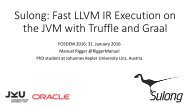BATTLE OF SKM AND IUM
1MHMIxh
1MHMIxh
You also want an ePaper? Increase the reach of your titles
YUMPU automatically turns print PDFs into web optimized ePapers that Google loves.
RECOMMENDATIONS<br />
• Microsoft should at the very least make HVCI (SKCI.DLL) verify its own integrity<br />
• CI.DLL does this, and is additionally protected by PEAUTH.SYS, PatchGuard, and Warbird<br />
• Even better, the Hypervisor (or an <strong>SKM</strong> component) should ensure that code pages are signed according<br />
to expected rules, and crash the machine if not<br />
• For example, <strong>IUM</strong> code should never be associated with a non-Microsoft root<br />
• <strong>SKM</strong> should disallow launching Trustlet IDs that it doesn’t know about<br />
• It already hardcodes Trustlet IDs in the <strong>SKM</strong> Capability Definitions<br />
• Microsoft won’t be releasing Trustlets on a frequent basis – and when it does, it can update <strong>SKM</strong><br />
• Better yet, actually enforce Secure Boot to be enabled, turned on, and with the expected certificates<br />
loaded, before allowing VSM to enable itself<br />
• Force the attacker to write their own hypervisor, not use yours<br />
• These are all defense-in-depth measures – obviously no way to truly protect against a physical attacker<br />
without Secure Boot




